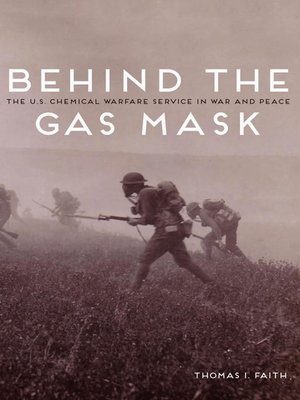
Sign up to save your library
With an OverDrive account, you can save your favorite libraries for at-a-glance information about availability. Find out more about OverDrive accounts.
Find this title in Libby, the library reading app by OverDrive.



Search for a digital library with this title
Title found at these libraries:
| Library Name | Distance |
|---|---|
| Loading... |
In Behind the Gas Mask, Thomas Faith offers an institutional history of the Chemical Warfare Service, the department tasked with improving the Army's ability to use and defend against chemical weapons during and after World War One. Taking the CWS's story from the trenches to peacetime, he explores how the CWS's work on chemical warfare continued through the 1920s despite deep opposition to the weapons in both military and civilian circles.
As Faith shows, the believers in chemical weapons staffing the CWS allied with supporters in the military, government, and private industry to lobby to add chemical warfare to the country's permanent arsenal. Their argument: poison gas represented an advanced and even humane tool in modern war, while its applications for pest control and crowd control made a chemical capacity relevant in peacetime. But conflict with those aligned against chemical warfare forced the CWS to fight for its institutional life—and ultimately led to the U.S. military's rejection of battlefield chemical weapons.
| Cover Title Contents Acknowledgments Introduction 1. Origins, 1917 2. Battle, 1918 3. Crisis, 1919–1920 4. Improvement, 1921–1925 5. Legacy, 1926–1929 Notes Bibliography Index | "Well-researched and informative. . . . a good look at American preparation for and experience with gas exposure in World War I."—The Journal of America's Military Past
"As the centennial anniversary of World War I is upon us and as chlorine gas is once again being used as a weapon of war in the Middle East, Faith's review of the birth of the Chemical Warfare Service is well-timed and pertinent."—H-Net Reviews
"Faith offers a compelling investigation of the U.S. Army's experience with chemical weapons in World War I. Ultimately the public and government rejected future use of chemical weapons in battle. If Americans had accepted the arguments of chemical weapons experts, twentieth-century warfare would have been even more terrifying. This book tells an important story of a path not taken, at least not yet."
—Jennifer D. Keene, author of Doughboys, the Great War and the Remaking of America
|Thomas I. Faith is a historian at the U.S. Department of State.
As Faith shows, the believers in chemical weapons staffing the CWS allied with supporters in the military, government, and private industry to lobby to add chemical warfare to the country's permanent arsenal. Their argument: poison gas represented an advanced and even humane tool in modern war, while its applications for pest control and crowd control made a chemical capacity relevant in peacetime. But conflict with those aligned against chemical warfare forced the CWS to fight for its institutional life—and ultimately led to the U.S. military's rejection of battlefield chemical weapons.
| Cover Title Contents Acknowledgments Introduction 1. Origins, 1917 2. Battle, 1918 3. Crisis, 1919–1920 4. Improvement, 1921–1925 5. Legacy, 1926–1929 Notes Bibliography Index | "Well-researched and informative. . . . a good look at American preparation for and experience with gas exposure in World War I."—The Journal of America's Military Past
"As the centennial anniversary of World War I is upon us and as chlorine gas is once again being used as a weapon of war in the Middle East, Faith's review of the birth of the Chemical Warfare Service is well-timed and pertinent."—H-Net Reviews
"Faith offers a compelling investigation of the U.S. Army's experience with chemical weapons in World War I. Ultimately the public and government rejected future use of chemical weapons in battle. If Americans had accepted the arguments of chemical weapons experts, twentieth-century warfare would have been even more terrifying. This book tells an important story of a path not taken, at least not yet."
—Jennifer D. Keene, author of Doughboys, the Great War and the Remaking of America
|Thomas I. Faith is a historian at the U.S. Department of State.







